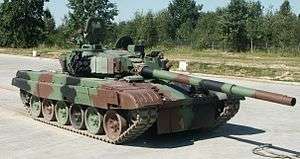PT-91 Twardy
The PT-91 Twardy ("hard","tough" or "resilient") is a Polish main battle tank. A development of the T-72M1, it first entered service in 1995. The PT-91 was designed at the OBRUM (OBRUM for Ośrodek Badawczo-Rozwojowy Urządzeń Mechanicznych – Polish for Research and Development Centre for Mechanical Appliances) and is produced by the Bumar Łabędy company, a part of the Bumar Group, a Polish technical military consortium. Changes from the T-72 include a new dual-axis stabilized fire-control system, reactive armour, a more powerful engine, transmission and new automatic loader. Unlike many other T-72 upgrades, the Polish Army PT-91s are upgraded using elements created almost exclusively by domestic companies, including a new engine, the fire control system and all communication system elements. Many of those elements were used to upgrade existing fleets of T-72 tanks in countries including the Czech Republic (T-72M4 CZ), Georgia (T-72SIM-1) and India (T-72 Ajeya Mk. 2).
History
In the late 1980s the Polish Army modernized all of its obsolete T-55 tanks to the T-55AM Mérida standard. The successful conversion convinced the General Staff that similar modernization could also be applied to other Soviet-designed tanks made in Poland and used by the Polish Armed Forces. In late 1988 it was decided to prepare a project of modernization for the T-72M1 design – using the experience from production of licensed T-72M (obiekt 172M-E3 – Polish army designation T-72), T-72M1 (obiekt 172M-E5), T-72M1K (Polish army designation T-72M1D).

The Gliwice-based Research and Development Centre of Mechanical Systems OBRUM (Polish: Ośrodek Badawczo-Rozwojowy Urządzeń Mechanicznych) was chosen as the main design bureau. However, initially the work progressed at a very slow pace, mainly because the Polish General Staff was also considering the purchase of a newer version of T-72 (T-72S) or the modern T-80.
After the political changes of 1989 and the dissolution of the Soviet bloc, Polish-Soviet talks on purchase of modern tanks came to a halt and the design of a new Polish tank gained momentum. The first design proposed by the bureau was code-named Wilk (Polish for wolf), but the project was cancelled. Instead, the priority was shifted to a different project named Twardy. The basic aim of the conversion of T-72 was to adapt it to the reality of modern warfare and fix its most visible deficiencies. Among those were low mobility, insufficient armour, lack of a fire control system and poor stabilisation of the main gun, which resulted in poor firing accuracy. An additional problem was lack of passive night vision aiming systems.
Development
Starting from July 1991 T-72 modernization programs were implemented by the Bumarcombine which had been producing T-72s under Soviet license. The modernized main battle tank was designated PT-91 Twardy. From base modification it differs in increased protection, fire control system and engine. In 1993 the Polish Defense Ministry ordered 20 PT-91 tanks to be used for field trials and Armed Forces tests.
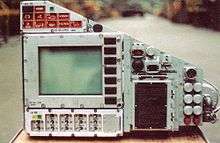
The main battle tank's protection from high-explosive anti-tank (HEAT) projectiles and missiles is increased by the new Erawa dynamic armor developed by the Poland Military-Technical Institute. This protection consists of 394 tiles with explosives, detonating in case of a direct hit. The tiles cover 9 m2 on the tank. 108 tiles are placed on the turret, 118 on the hull and 84 on each side's anti-HEAT screens. The Twardy uses steel anti-HEAT screens instead of the rubber used on the T-72. Erawa's main difference from the Soviet analogs is that Erawa's containers fit almost without gaps while on the Soviet modernized T-72 gaps reach 10–15 mm noticeably decreasing defense effectiveness. There are two Erawa modifications: Erawa-1 and -2, differing in weight of the explosives.
Experiments showed that the Erawa dynamic defense decreases the high-explosive jet impact depth by 50–70% and penetrator (APFSDS) projectiles by 30–40%. Furthermore, explosive containers do not detonate when hit by shot of up to 30 mm calibre, shell or mine fragments, or when covered in burning napalm or petrol.
The Twardy is armed with the same 125 mm smoothbore gun 2A46 used in the T-72, fitted with an automatic reloading mechanism which reduced the tank crew by one as it replaced the gun loader, and gave a rate of fire of 8 to 10 rounds per minute. Additional armament comprises the 7.62 mm PKT coaxial general-purpose machine gun and 12.7 mm NSVT anti-aircraft heavy machine gun. The PT-91 has a thermosmoke device generating smoke screens from fuel and 24 grenade launchers fitted with smoke or anti-personnel frag grenades.
The modernization of the fire control system started by replacing the earlier used Soviet two plane stabilizer 2Є28M with a new stabilizer developed in Slovakia. It has an electronic information block showing the tank's technical condition. Furthermore, it informs the commander when effective sighted fire becomes ineffective because of an excessively high cross-country speed or other reasons.

The Drawa fire control system, developed by Polish engineers, contains the gunner's day sight PCD and the TES thermovision night sight developed by the Israeli company El-Op, the commander's combined day-night passive observation and aiming sight POD-72, a ballistic computer, a laser rangefinder and a data system processing information for the ballistic computer. The sighting of the ballistic computer depends on the target's speed, weather conditions, projectile temperature and projectile type.
The driver uses the control and diagnostic complex US-DK-1 controlling the tank's main systems and displaying information on a monitor. The driver's night sight was replaced by the Radomka passive night sight.
The modernized tank's increased weight led the developers to add a more powerful engine. It is a 12-cylinder S-12U diesel engine, a modernized version of the Soviet V-46-6 produced in Warsaw by PZL-Wola (850 hp instead of 780). The main improvement is the modernized fuel and air injection system. This caused a noticeable decrease in the tank's road endurance. The latest Twardy variants have the 1,000 hp S-1000 engine with a turbocharger.
Variants
PT-91 Twardy
Production variant for Polish Army, extensively modernized development of T-72M1. Most of the vehicles are equipped with SKO-1M Drawa-1T dual-axis stabilized fire control system (with TES – Thermal Elbow Sight – total number of delivered thermal sights is 202[4]) though some early production vehicles have a SKO-1 Drawa (with NV sight), Erawa reactive armour, a PCO SSC-1 Obra-1 laser-warning system and 850 hp PZL-Wola S-12U engine.[5] The first 20 initial production vehicles were delivered to Polish Land Forces in 1993–1994 with another 78 full-scale production vehicles delivered 1995–1997, 135 modernized T-72M1 tanks (made in late 80s) delivered 1998–2002. Both new and modernized tanks have the same combat capabilities.[5] Depending exact configuration Polish Army uses PT-91s in 3 variants PT-91, PT-91M and PT-91MA1.[6]
PT-91A Twardy
Development variant with PZL-Wola S-1000 1,000 hp engine with mechanic transmission and number of other minor changes. Used for trials and as demonstrator on military exhibitions.
PT-91Z Hardy
(Z for Zmodernizowany – literally Modernized) Further development with SAGEM Savan-15 fire control system, according to life fire test Savan-15 has only minor advantage in accuracy over Drawa.[7] The biggest advantage was a new gun stabilization system that gave the tank a significant increase in accuracy when the tank is on the move. Later it was used as a base to develop the PT-91M. This variant has won a number of stress tests in Malaysia over T-90, T-84 and K1 tanks, and has won the competition for a new Malaysian MBT. Only one prototype was made.
PT-91M Pendekar
(M for Malaysia) — production export variant for Malaysia with Sagem Savan-15 fire control system, a new 1,000 hp powerpack with Renk automatic transmission bringing its top speed to 70 km/h. Its main gun have been changed to a ZTS 2A46MS 125 mm gun, a 7.62 mm FN MAG coaxial machine gun and a 12.7 mm FN Browning M2 HB AA machine gun. This variant is also equipped with Sagem panoramic sight, a Sagem laser gyro inertial navigation system, turret stabilisation system, Obra-3 laser-warning system, integrated with 81 mm smoke grenade launchers, CBRN warning and protection system, Thales communication systems. ERAWA 2 Explosive Reactive Armour, and German-made tank tracks. Two prototypes made (renamed PT-91E and PT-91Ex), 48 serial PT-91M Malaj vehicles produced 2007–2009.[3][8]
PT-91E/Ex
(E for Export) – renamed prototypes of PT-91M used as demonstrators of export variant showed on military exhibitions. PT-91E is a first prototype named SP1 (it is same vehicle as shown on military parade in Kuala Lumpur in 2005), PT-91Ex is a second prototype named SP2.[3] Both vehicles faced number of tests in Malaysia SP1 was used for traction tests and has made 7000 km offroad in Malaysia, SP2 2000 km and 500 shoots from main cannon.[5] Very similar to PT-91M, offered for export to other countries.
PT-91P
(P for Peru) – Demonstrator for SITDEF Peru'2009 military exhibition. A cheaper alternative to PT-91Ex. This variant is equipped with newest PCO Drawa-TG fire control system with a thermal sight and modern communication system (Radmor RRC9310 radio, WB Electronics Fonet-IP communication system and Teldat battlefield management system). The vehicle was shown at a number of South American events including SITDEF Peru'2009 Expo.[9][10][11]
PT-72U / PT-91U / PT-91EU
(U for Urbanizowany – Tank to fight in urbanized terrain) – Demonstrator for MSPO 2011 military exhibition. This is an offer for the Polish Army which involves certain modifications of the T-72 and PT-91 tanks. The modification includes installation of additional equipment, as remote-controlled cannon with an optical system, an omnidirectional observation system, add-on armour and further engineering equipment. For the weapons systems, the PT-72U is equipped with a remote controlled weapon station armed with a 12.7 mm machine gun, mounted to the crew commander hatch. The system had a fire rotation of 360° and an elevation angle for the gun from -5° to 55°. The observation system is equipped with 8 day-night cameras with the observation angle 55° and a rotary passive camera FLIR which has up to 26 times optical zoom. The armour package is composed by chassis and turret bar armour. The bottom of the chassis is equipped with reactive armour and add-on armour. The PT-72U is also equipped with a full range of new modern internal and external communication tools, which allow communication also via internet.[12] There were also plans to modernize 84 Armenian T-72s to PT-72U standard.[13]
PT-16
Further development introduced in 2016. Upgrades include improved armor, armament, and mobility. The hull armor and cast turret have been upgraded with add-on composite armor equivalent to up to 1000mm RHA (rolled homogenous armor), supplied by Germany. The protection can also be improved with Polish ERAWA explosive reactive armor. The 125mm smoothbore cannon has been replaced with a 120mm smoothbore cannon compatible with NATO ammunition, and uses a carousel type autoloader. This autoloader is separate from the crew compartment, where the T-72 autoloader was located. The manned 12.7mm machine gun has been upgraded to be remotely operated. Other improvements include an upgraded fire control system. The tank is proposed to be fitted with a new engine, options for which include an unspecified Serbian turbocharged diesel, a German 1088hp, Serbian V46-TK, and potential, to be developed, 1200hp engines. Other improvements include rubber skirts covering the lower hull and the tracks, and new tracks based on those found on German Leopard 2s, which can be fitted with deep wading kits to allow it to ford water obstacles up to 13 feet (4 meters) deep. The upgrade can be applied to both PT-91s and T-72M1s, of which Poland has a total of 823 (233 PT-91s, 120 active T-72M1s, and 470 reserve T-72M1s). [14]
Related Vehicles
WZT-3

WZT is the acronym of for Wóz Zabezpieczenia Technicznego literally Technical Support Vehicle: it indicates a family of armoured recovery vehicles based on the PT-91/T-72 tank hull, with over 400 vehicles delivered to the clients. It is armed with a 12.7 mm ( 1⁄2 in) machine-gun fitted to the commander’s hatch. Standard equipment includes: crane with telescopic jib that can lift a maximum load of fifteen tonnes, front-mounted stabilizing dozer blade, main and secondary winches.
- WZT-3 – A T-72 based variant for Polish Army – 20 vehicles.
- WZT-3M – A PT-91 based variant for Polish Army – 9 new vehicles and 20 WZT-3 upgraded to this standard.
- M-84AI – A M-84A based variant, made on licence in Yugoslavia – 15 vehicles for Kuwait
- ARV-3 – A T-72 based variant for Indian Army – 352 vehicles made
- WZT-4[15] – A PT-91M based variant for Malaysian Army (technically this vehicle is closely related to MID-M) – 6 vehicles
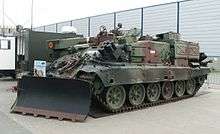
MID Bizon-S
(MID for Maszyna Inżynieryjno-Drogowa – lit. Engineering-Roading Machine; Bizon is Polish for Bison) – Polish engineering tank based on the PT-91 tank hull.
- MID – A PT-91 based variant for Polish Army – 8 vehicles
- MID-M – A PT-91M based variant for Malaysian Army – 3 vehicles
PMC
(PMC for Pomocniczy Most Czołgowy – lit. Auxiliary Tank Bridge) – Polish Armoured Vehicle Launched Bridge is a close support bridge layer. The PMC-90, developed on the basis of PT-91, is able to carry out missions required to operations of combat forces.
- PMC-90 – PT-91 based prototype vehicle with MLC-60 bridge. Not adopted.
- PMC-Leguan – PT-91M based variant for Malaysia equipped with the 26 m (87 ft) long MLC 60 Leguan bridge system. 5 vehicles for Malaysia.
- MG-20 Daglezja-G[16] (MG for Most Gąsienicowy – lit. Tracked Bridge) – a tracked bridge system, based on a lengthened T-72 chassis with one additional road wheel, equipped with a MLC-70 bridge system. Closely related to a truck based MS-20 Daglezja. Currently in development phase, it is expected to replace a T-55 based BLG-67M bridges in Polish Army.
PZA Loara
The PZA (Przeciwlotniczy Zestaw Artyleryjski, meaning "AA Artillery System"; “Loara” means “Loire (river)” in Polish) is an armored self-propelled anti-aircraft artillery system developed in the late 1990s. Based around the Twardy chassis, this system mounts an armoured turret holding two Oerlikon KDA 35 mm cannons linked to a radar fire control system. It was planned that it would work closely together with PZR “Loara” (anti-aircraft rocket system) vehicles built on the basis of the PZA Loara but that project is currently on hold. The Loara is an autonomous fire unit capable of performing its tasks independently or acting as a component of a wider air defense system. The system has two radars, 3D search radar and engagement radar. The search radar has a range of 26 km (16 mi) and is capable of tracking and identifying up to 64 targets at once. The radar system can also be operated on the move, refreshing its data every second. The system also has a laser range-finder, TV and FLIR cameras giving the system both all-weather day/night capabilities and the ability to operate entirely passively in a heavy ECM environment. The system also has a reaction time less than 10 seconds. The system can engage aircraft flying at altitudes from very low altitudes up to 5,000 m (16,500 ft), and flying at speeds up to 500 m/s (1,125 mph). It is also effective against lightly armored ground and naval targets.
SJ-09
SJ-09 is one of the elements of the T-72 and PT-91 crew training system. The system is composed of both trainers teaching crew trainees how to operate different systems of the tank and simulators allowing training more advanced situations. For example, the SJ-02 is used tech how to load a main gun. SJ-09 is the driver training vehicle used to train divers in operating of the vehicle as big and heavy as main battle tank. The vehicle itself is a tank chassis that have turret replaced with instructor station. All unnecessary equipment (like side skirts) was removed, the vehicle have a dummy main gun that obstructs drivers view (like in the real tank). Vehicles used by Polish Army were rebuilt from the few original T-72 Ural in polish inventory delivered from Soviet Union; another vehicle was built new for Malaysian Army as a part of PT-91M order.
PT-94 Goryl
(Goryl is Polish for Gorilla) – project of a Polish main battle tank designed using experience gained on PT-91 project. The tank would be similar in its design to Merkava (engine at front), and it would feature redesigned engine, transmission and fire control system. Armor: composite + ERA, main armament: 120/125 mm gun, 60 mm mortar, secondary armament: 7.62 mm PKT coaxial machine gun, 12.7 mm NSWT AA machine gun, crew: 3. This program was also known under the name Anders. The program was cancelled at early stage.
PT-97 Gepard
The Gepard (Polish for Cheetah), sometimes known as PT-2001, is another modification project of a Polish main battle tank prepared as future modernisation programme for T-72 family, the programme was called for, as first PT-91 proposition fell below requirements. Two propositions were submitted, one by Bumar which provided a project with modified frontal armor, different mortar and sporting Leclerc–like turret with the 2A46 main gun. OBRUM's competing project had new front and sides reactive armor and L-44 main gun.
Despite considerable improvements, neither was approved for financial reasons, and no prototypes were built, however design experience helped with new PT-91 versions.
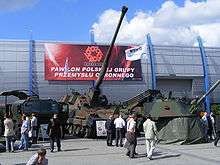
Krab
The Krab (Polish for Crab) is a 155 mm NATO-compatible howitzer designed by HSW S.A. combining OBRUMs UPG chassis, licensed AS-90M Braveheart turret with 52-calibre gun and WB Electronics Artillery Fire Control System Topaz. The Howitzer is equipped with S-12U engine and other elements (like road wheels) from PT-91.
Operational history
Poland
233 PT-91s were delivered between 1995 and 2002 (232 vehicles remain in service, the early prototype is preserved in the Land Forces Training Center museum in Poznań) and 38 support vehicles based on the T-72/PT-91 hull (29 WZT-3M armoured recovery vehicles, 8 MID engineering tank and 1 prototype PZA Loara self-propelled anti-aircraft weapon).
| Number of PT-91s delivered to Polish Land Forces each year[17] | ||||||
|---|---|---|---|---|---|---|
| 1995–1996 | 1997 | 1998 | 1999 | 2000 | 2001 | 2002 |
| 58 | 58 | 7 | 33 | 50 | 20 | 7 |
Units equipped with PT-91 Twardy:
- 1 Warszawska Brygada Pancerna (1st Armored Brigade) – one battalion, Warsaw district – Wesoła
- 2 Brygada Zmechanizowana Legionów (2nd Mechanized Brigade) – one battalion, Złocieniec[18]
- 9 Brygada Kawalerii Pancernej (9th Armored Cavalry Brigade) – two battalions, Braniewo
- Centrum Szkolenia Wojsk Lądowych (Land Forces Training Center) – Poznań[4]
Former units equipped with PT-91 Twardy:
- 10 Brygada Kawalerii Pancernej (10th Armored Cavalry Brigade) – Świętoszów (replaced with Leopard 2A4)
- 15 Wielkopolska Brygada Kawalerii Pancernej (15th Armored Cavalry Brigade) – Wędrzyn (unit disbanded in June 2007)
- 17 Wielkopolska Brygada Zmechanizowana (17th Mechanized Brigade) – Międzyrzecz (replaced with KTO Rosomak)
- 34 Brygada Kawalerii Pancernej (34th Armored Cavalry Brigade) – Żagań (replaced with Leopard 2A5)
At the introduction of PT-91 the intention of Polish General Staff was to equip all brigades of 11th Armored Cavalry Division with PT-91, at the time the division had 4 brigades: 10th Armored Cavalry, 15th Armored Cavalry, 17th Mechanized and 34th Armored Cavalry.
In 2002, 10th Armored Cavalry received Leopard 2A4 tanks donated to Poland by Germany, in 2007 the 15th Armored Cavalry was disbanded and the 17th Mechanized received the first KTO Rosomak. All these changes allowed the reallocation of PT-91s to other divisions, replacing the oldest T-72s. In the early 2014 the 34th Brigade from Żagań received the first Leopard 2A5 tanks, shifting its PT-91 to the 9th Brigade in Braniewo, previously using T-72M1.
A typical Polish PT-91 tank battalion equipped with 53 tanks is composed of 4 frontline companies with 13 vehicles in each and 1 tank for the battalion commander. Every company of 13 tanks is composed of three platoons with 4 tanks in each and 1 tank for the company commander.
Malaysia
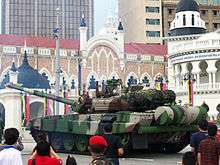
In 2007–2009 Bumar Łabędy delivered to Malaysia 48 PT-91M and 15 support vehicles (6 WZT-4 {WZT-91M} armoured recovery vehicle, 3 MID-M {MID-91M} engineering tank, 5 PMC Leguan {PMC-91M} - armoured vehicle-launched bridge and one SJ-09 driver training tank), ammo, spares and support for $370 million USD.[3][8] Operating capability since 1 September 2010.[19][20]
| Number of PT-91M delivered to Malaysian Land Forces each year[21] | ||||||
|---|---|---|---|---|---|---|
| 2005 | 2006 | 2007 | 2008 | 2009 | ||
| SP1 prototype for trials | SP2 prototype for trials | 6 | 24 | 18 + 15 support vehicles | ||
Units equipped with PT-91M:
- Rejimen ke-11 Kor Armor DiRaja – (11th Regiment of Royal Armoured Corps) – Gemas
Rejimen ke-11 KAD is the sole user of PT-91M in Malaysian Army, PT-91M has replaced FV101 Scorpion light tank.
India
In April 1999, India ordered 44 WZT-3 armored recovery vehicles, which was followed by another two orders in April 2002 ( 80 vehicles), and in July 2005 (228 vehicles) – for a total of 352 WZT-3 armored recovery vehicles ordered. These vehicles are used to support the T-72 and T-90 MBT.[21] Deliveries began in 2001, and India is planning to upgrade its Ajeya Mk1 tanks (local name for T-72M1) to Ajeya Mk2 standard, with some elements from PT-91, such as the Drawa-TE1 fire control system and the PZL-Wola S-1000 engine. In October 2011, Indian Defense Ministry announced that the state owned BEML will produce an additional 204 WZT-3 armored recovery vehicles – taking the total till 2011 to 556 vehicles.[22] The Ministry also clarified that no Global Tender was floated since it was a repeat order.
Georgia
Georgian army upgraded T-72SIM-1 tanks are using Drawa-T fire control system, a development of the fire control system on PT-91. The FCS is equipped with laser range finder and thermal imaging sensor. The system is slightly different from the one used on Polish PT-91s, commander is using an LCD screen instead of the eyepiece. The Thermal Elbow Sight thermal imaging sensor used in Georgian tanks is of the same (Israeli) origin as the one used on PT-91 but the external housing is different.[23]
Operators

Current operators
References
- 1 2 3 4 5 6 7 8 "PT-91 on Modern Tanks"
- ↑ "PT-91A on Modern Tanks"
- 1 2 3 4 5 6 7 8 9 10 11 12 13 14 15 Nowa Technika Wojskowa – November 2007 page 15 – Pokaz "Malaja" i CV90120-T na Drawsku – by Andrzej Kliński
- 1 2 Nowa Technika Wojskowa – May 2008 page 22 – Odmłodzona Drawa – by Andrzej Kliński
- 1 2 3 Nowa Technika Wojskowa – September 2007 page 14 – Jak można zmodernizować Twardego? - by Andrzej Kliński
- ↑ Nowa Technika Wojskowa – September 2008 page 40 – Polskie wojska pancerne i zmechanizowane – meandry rozwoju – by Norbert Bączyk
- ↑ Nowa Technika Wojskowa – November 1999 page 18 – Polskie T-72 – Co dalej? - by Tomasz Begier and Dariusz Użycki
- 1 2 Nowa Technika Wojskowa – October 2005 page 9 – Pierwsza prezentacja "Malaja" - by Andrzej Kliński
- ↑ Nowa Technika Wojskowa – April 2009 page 16 – Twardy na wystawie w Peru – by Andrzej Kliński
- ↑ Altair – PT-91P popłynął na SITDEF Peru 2009 Archived April 13, 2009, at the Wayback Machine.
- ↑ "Peru army plans arms purchase, tests Chinese tanks". Associated Press. 2009-12-09. Archived from the original on 2009-12-14.
- ↑ "The new PT-72U main battle tank for urban operations at MSPO 2011". Army Recognition.
- ↑ http://dziennikzbrojny.pl/aktualnosci/news,3,4148,aktualnosci-ze-swiata,polacy-zmodernizuja-czolgi-t-72-armenii
- ↑ PT-16 Main Battle Tank | Military-Today.com
- ↑ Nowa Technika Wojskowa – September 2008 page 16 - "Wuzetka" dla Malzezji – by Andrzej Kliński
- ↑ Nowa Technika Wojskowa – September 2008 page 26 – Most samochodowy MS-20 Daglezja – by Michał Sitarski
- ↑ Nowa Technika Wojskowa – November 2004 page 20 – Polska w rejestrze uzbrojenia konwencjonalnego ONZ – by Jarosław Ciślak
- ↑ Rp.pl. "Afera czołgowa w polskiej armii". rp.pl. Retrieved 2011-11-14.
- ↑ "Gotowość operacyjna PT-91M". Altair. Retrieved 2011-11-14.
- ↑ "Ulang Tahun Kor Armor Diraja ke 58". YouTube. 2010-09-03. Retrieved 2011-11-14.
- 1 2 Nowa Technika Wojskowa – February 2009 page 10 – Malaj na finiszu – by Andrzej Kliński
- ↑ "More Armored Recovery Vehicles for Indian Army". Defense News. 2011-10-17. Retrieved 2011-11-14.
- ↑ "Бронетехника в грузино-осетинском конфликте август 2008 – 0001.htm". Vadimvswar.narod.ru. Archived from the original on 2011-09-30. Retrieved 2011-11-14.
External links
| Wikimedia Commons has media related to PT-91 Twardy. |
- PT-91 on Bumar-Łabędy Web Site
- PT-91Ex on Bumar-Łabędy Web Site
- PT-91 Twardy Main Battle Tank at globalsecurity.org
- PT-91 Twardy main battle tank Polish Defense industry at armyrecognition.com
